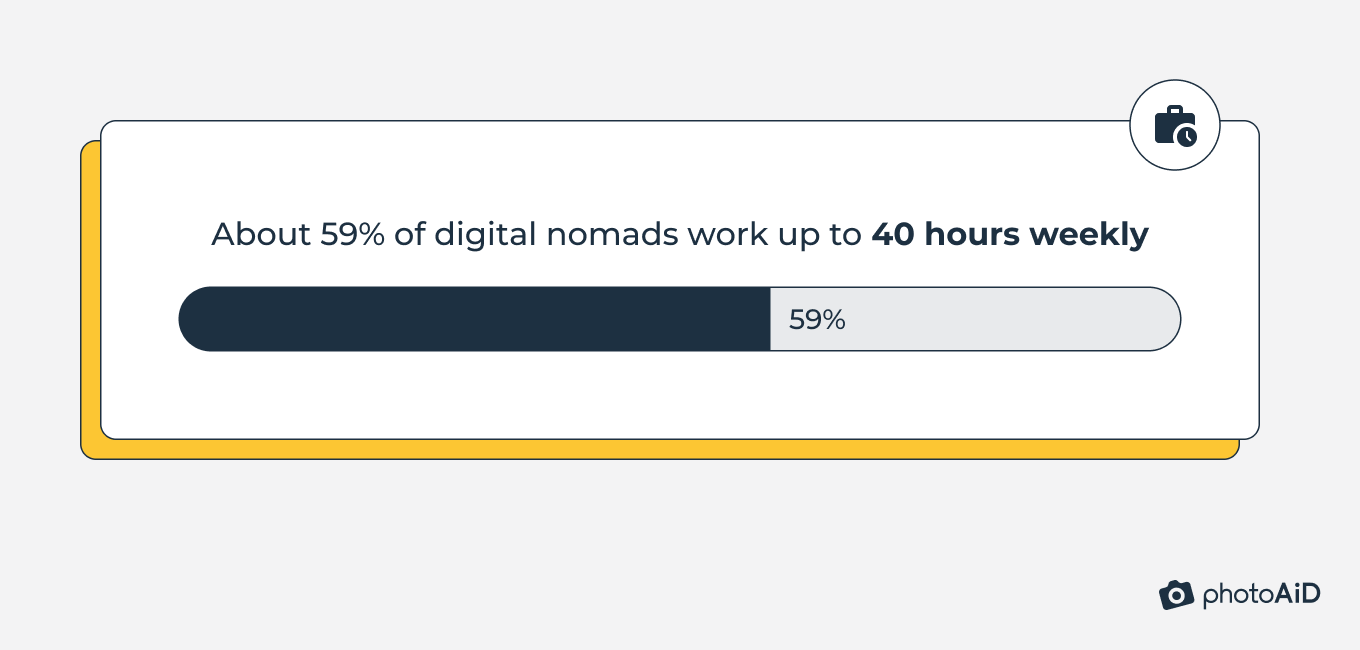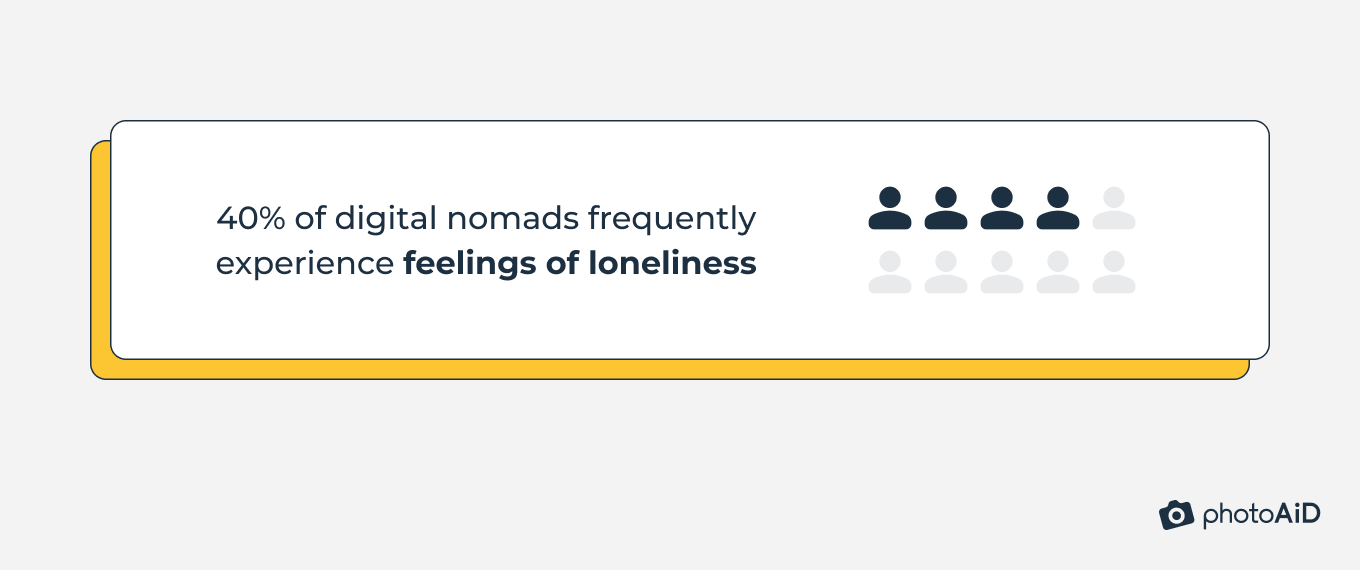Welcome to our curated and vetted list of 47+ digital nomad statistics for 2023.
Top Digital Nomad Statistics
- As of 2023, 11% of US workers (17.3 million) identify as digital nomads.
- Men comprise 56% of digital nomads, women 43%, and nonbinary 1%.
- Digital nomads have a median age of 39.
- Nearly half (42%) of digital nomads have a household income exceeding $75,000.
- About 59% of digital nomads work up to 40 hours a week.
Demographics
01. Digital nomads consist of 68% full-timers and 32% part-timers.
02. Gen Z (21%) and Millennials (37%) make up 58% of digital nomads.
| How Old Are Most Digital Nomads? | Age |
|---|---|
| Gen Z | 21 |
| Millennials | 37 |
| Gen X | 27 |
| Baby Boomers | 15 |
03. Digital nomads have a median age of 39.
04. Men comprise 56% digital nomads, women 43%, and nonbinary 1%.
05. Roughly 73% of digital nomads are white.
| Racial Distribution of Digital Nomads (2023) | In % |
|---|---|
| White | 73 |
| African American | 18 |
| Hispanic | 11 |
| Asian | 4 |
| Another background | 3 |
06. Heterosexuals comprise approximately 86% of digital nomads.
| Sexual Orientation of Digital Nomads (2023) | In % |
|---|---|
| Heterosexual | 86 |
| Bisexual | 8 |
| Gay or lesbian | 5 |
07. A majority (55%) of digital nomads aren’t religious.
08. As of March 2023, nearly 50% of digital nomads come from the US.
| Distribution of Digital Nomads by Nationality (2023) | In % |
|---|---|
| United States | 48 |
| United Kingdom | 7 |
| Russia | 5 |
| Canada | 4 |
| Germany | 4 |
| France | 3 |
| Australia | 2 |
| Brazil | 2 |
| Netherlands | 2 |
| Spain | 2 |
| India | 1 |
| Ukraine | 1 |
| Poland | 1 |
| Italy | 1 |
| Switzerland | 1 |
| Austria | 1 |
| Sweden | 1 |
| Ireland | 1 |
| Israel | 1 |
| Czech Republic | 1 |
| Belgium | 1 |
| Japan | 1 |
09. About 90% of global digital nomads have higher education, and 54% have a bachelor’s degree.
| Education Levels of Digital Nomads Globally (as of March 2023) | In % |
|---|---|
| Higher education | 90 |
| of which Bachelor’s | 54 |
| of which Master’s | 33 |
| of which PhD | 3 |
| High school | 10 |
10. More than half (54%) of digital nomads are married or live with a partner.
11. Digital nomads are more likely to be early adopters of technology at 77%, compared to non-digital nomads at 43%.
12. Nearly 42% of digital nomads lean towards identifying as free agents rather than loyal employees, unlike traditional jobholders (29%).
13. Roughly 79% of digital nomads use technology to have a competitive edge, compared to 44% of non-digital nomads.
14. About a quarter (24%) of American digital nomads travel with their kids.
15. Nearly 14% of digital nomads travel with pets.
16. Most digital nomads (61%) work from home offices.
| Places Where Nomads Typically Work (2023) | In % |
|---|---|
| Home office | 61 |
| Coworking | 15 |
| Cafe | 8 |
| Office | 5 |
| Dining table | 4 |
| Couch | 3 |
| Bed | 2 |
| Balcony | 1 |
17. The leading social cause for digital nomads is climate change, at 42.5%.
18. More than four in five (81.9%) digital nomads factor in their impact on local communities.
Sources: Flatio, MBO Partners, Nomad List
Work Habits and Satisfaction
19. As of 2023, 11% of US workers (17.3 million) identify as digital nomads—a 2% rise from 2022 and 131% from 2019 to 2022.
| Yearly Count of US Digital Nomads: 2019–2023 | In Millions |
|---|---|
| 2019 | 7.3 |
| 2020 | 10.9 |
| 2021 | 15.5 |
| 2022 | 16.9 |
| 2023 | 17.3 |
20. In 2023, 70 million US adults said they intend to become digital nomads in the next 2–3 years, a 3% drop from 2022.
| Annual Interest in Digital Nomadism among US Adults: 2020–2023 | In Millions |
|---|---|
| 2020 | 54 |
| 2021 | 65 |
| 2022 | 72 |
| 2023 | 70 |
21. About 19% of digital nomads report annual household incomes below $25,000, while 42% report incomes of $75,000 or more. Keep in mind that income reporting is challenging because digital nomads are a blend of full-timers (68%) and part-timers (32%).
22. Regardless of income, most digital nomads are satisfied with their earnings, with 82% being very satisfied (47%) or satisfied (35%).
23. About 59% of digital nomads work up to 40 hours a week.

24. More than half (52%) of digital nomads regularly work on weekends.
25. Roughly 77% of digital nomads have suffered from burnout.
26. Close to 80% of digital nomads still report high job satisfaction.
27. Nearly 79% of digital nomads are optimistic about their career’s future.
Sources: MBO Partners, Passport Photo Online
Occupation
28. As of March 2023, marketing (16%) and creative (16%) roles top the list for global female digital nomads.
| Top Professions of Global Female Digital Nomads (as of March 2023) | In % |
|---|---|
| Marketing | 16 |
| Creative | 16 |
| Startup Founder | 13 |
| Software Dev | 10 |
| UI/UX Design | 9 |
| Blogging | 9 |
| Web Dev | 8 |
| Community | 8 |
| Education | 8 |
| Product Manager | 7 |
| Coach | 7 |
| Data | 6 |
| Ecommerce | 5 |
| SaaS | 5 |
| Finance | 4 |
29. As of March 2023, 34% of global male digital nomads work in software development and 29% in web development.
30. One-third of digital nomads with conventional roles are employed by fully remote firms.
31. About 14% of traditionally employed digital nomads say their company doesn’t know they are nomadic. Another 18% have their boss’s nod despite no official digital nomad policy.
Sources: MBO Partners, Nomad List
Travel Choices
32. Most digital nomads (89%) remain in one spot for no more than six months.
33. As of March 2023, the US is the leading destination for digital nomads, capturing 15% of their trips.
| Top Countries Frequented by Global Digital Nomads (as of March 2023) | In % |
|---|---|
| United States | 15 |
| Spain | 5 |
| Thailand | 5 |
| United Kingdom | 4 |
| Germany | 4 |
| Mexico | 4 |
| France | 3 |
34. As of March 2023, London is the top city for digital nomads, making up ~2.4% of their trips.
| Most Popular Cities for Digital Nomads (as of March 2023) | In % |
|---|---|
| London (United Kingdom) | 2.4 |
| Bangkok (Thailand) | 1.94 |
| New York City (United States) | 1.65 |
| Berlin (Germany) | 1.6 |
| Paris (France) | 1.55 |
| Lisbon (Portugal) | 1.5 |
| Barcelona (Spain) | 1.46 |
35. Nearly 47% of digital nomads prioritize cost when choosing their next destination, with sunshine coming second at 15%.
| What Influences Digital Nomads’ Destination Choices? | In % |
|---|---|
| Cost | 46.6 |
| Sunshine | 15 |
| Safety | 12 |
| Wi-Fi quality | 9.4 |
| Good healthcare | 6.1 |
36. About 36% of US digital nomads plan to be more domestically rooted next year, with just 18% looking to increase their time overseas.
37. As of 2023, 58 nations have launched digital nomad visas or similar initiatives, simplifying the relocation process for these remote workers.
38. Nearly 44% of digital nomads have never applied for a digital nomad visa.
Sources: Flatio, MBO Partners, Nomad List, Passport Photo Online
Obstacles Digital Nomads Face
39. Roughly 41% of digital nomads believe their way of life hinders their romantic relationships.
40. About 83% of digital nomads grapple with guilt when disconnecting or taking breaks from work.
41. On average, 40% of digital nomads frequently experience feelings of loneliness.

42. Financial stability weighs on the minds of nearly 77% of digital nomads.
43. A mere 12% of digital nomads are free from FOMO. Of the rest, 41% feel it occasionally, 21% often, and 26% always.
44. About 84% of digital nomads have encountered tax-related difficulties.
45. Personal safety (26%), balancing work with travel (24%), and distance from family and friends (22%) are the main concerns for digital nomads.
| Main Hurdles Faced by Digital Nomads | In % |
|---|---|
| Personal safety | 26 |
| Managing work and travel | 24 |
| Being away from family and friends | 22 |
| Time zone differences making work difficult | 21 |
| Loneliness | 21 |
| Travel logistics | 19 |
46. Given that 71% of nomadic kids are in the school-going age, education is a major challenge.
47. Nearly 40% of digital nomads cite finding accommodation as their top annoyance.
Sources: Flatio, MBO Partners, Passport Photo Online
Stacking It All Up
That concludes our deep dive into digital nomad statistics.
If you think this information would benefit your audience, you’re welcome to share it. Just remember to link back to this page as a nod to our efforts.
FAQ
How many Americans are digital nomads?
What age are most digital nomads?
What’s the gender ratio of digital nomads?
How many hours do digital nomads work?
How much do digital nomads make?

As a Digital PR specialist and a member of the Society of Professional Journalists (SPJ), I have 5+ years of writing experience.
Over the course of my career, my work has garnered significant attention, with features in numerous prominent publications such as The New York Times, Forbes, Inc., Business Insider, Fast Company, Entrepreneur, BBC, TechRepublic, Glassdoor, and G2.









